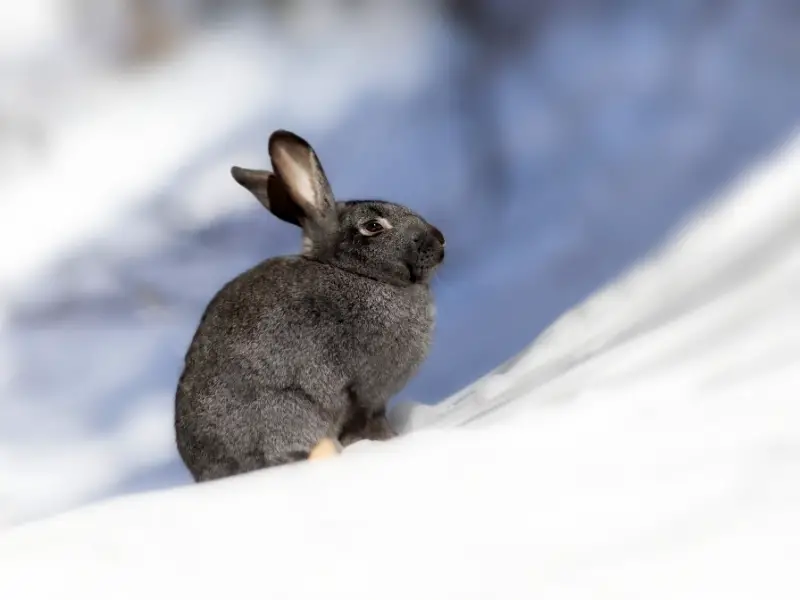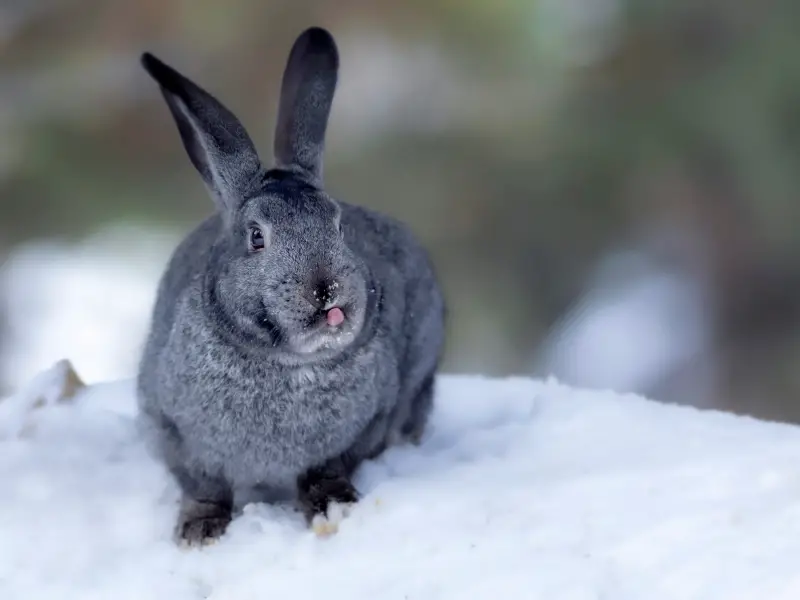As the weather turns cold and you feel more chilled, you may wonder if your pet rabbit also feels the cold. And if so, what can you do about it?
Rabbits thrive in the cold. But when your bunny’s internal temperature is under 100 ℉, keep it warm by bringing your bunny inside, insulating the hutch, placing heating pads or a thermal water bottle in the cage, adding extra bedding, and ensuring you keep drafts out of the hutch.
Let’s learn more about how you can keep your rabbit warm in the winter, and when you need to help your bunny warm up.
Do Rabbits Need Extra Warmth in Winter?
Rabbits are comfortable in temperatures 50-70 ℉. If it drops to 15 ℉, your bunny may still be ok, provided its coat is dry and there is no wind.
If it is cold and your bunny is wet, then it means its thick coat takes too long to dry. As a result, your rabbit could become hypothermic and die.
So do you need to keep your rabbit warm during the winter months? This very much depends on how cold your winters are and whether your rabbit lives in an outside hutch or stays inside your home with you.
If you have mild winters, then chances are you don’t need to provide extra warmth for Ms. Fluffles.
However, you should regularly check on your rabbit to make sure it is healthy and its internal temperature stays between 101-103 ℉. If the internal temperature of your bunny drops, then you need to take action.
If you have excessively cold weather in winter, where the outside temperature drops below 15 ℉, then you need to provide extra warmth for your bunny and ensure it has adequate protection from the cold.
If your rabbit is housed inside your home, then your pet should be ok. But if they stay outside, there are steps to take to ensure your rabbit hutch is winter-proofed.
How to Keep Rabbits Warm

To keep your rabbit warm during winter, follow these tips:
Weather-Proof the Hutch
This is key if your rabbit’s hutch is outside. To ensure the hutch is ready for winter:
- Make sure no water from melting snow or rain can make its way inside.
- Cover at least three sides of the hutch to keep the wind out.
- Cover half of the fourth side of the hutch if needed.
- Insulate the hutch with cardboard boxes or thick blankets. You can also look at heavy-duty insulation boards.
- Raise the hutch from the ground so frost from the ground can’t creep into your rabbit’s home.
Move the Hutch
If your winters are too harsh and cold, then moving the hutch indoors might be best. Slowly acclimatize your rabbit by placing the hutch in an enclosed patio, then your basement or garage, and finally inside the house.
Just be cafe about the hutch’s placement in the garage as car fumes are not healthy for rabbits to inhale.
Get a Nesting Box
Nest boxes or bed boxes that are the correct size help your rabbits stay out of the wind in their outdoor hutch. This is almost like an underground burrow that wild rabbits dig in the ground, so your bunny will be extra happy.
The bed box should be big enough so your rabbit can easily turn around when inside. All the sides and the bottom of the box should be made from solid wood.
For the door to the nest box, add a double door or a flap to keep the wind out.
Add Straw Bedding
Straw is a natural insulator, so adding this to your rabbit’s hutch and nesting box helps keep your bunny warm. You can also use more hay for the cage or bed box.
It is ideal to fill the bed box up to two-thirds capacity with straw or hay. This allows Mr. Fluffles to burrow in and stay warm.
Regularly Change the Bedding
Your rabbit’s bedding will get wet in the colder months so it is best to check the bedding frequently and change it for dry hay or straw.
Add a Heating Pad or Water Heater
You can also add a heated pad or water heater to your rabbit’s hutch.
If you add a water heater, you need to have access to electricity; if you don’t have power near the hutch, then a heating pad or even a thermal water bottle is a great solution.
Simply place the bottle or pad in your bunny’s cage or hutch. If your rabbit is cold, it will migrate to the heating pad to warm itself up.
How to Care for Rabbits During Winter
There are a few ways in which you can care for your rabbit, besides adding extra warmth and winter-proofing the hutch:
Ensure the Drinking Water Doesn’t Freeze
You want to make sure that Mr. Fluffles’ water in his water bowl doesn’t freeze. Regularly check on the water and replace it with fresh drinking water.
Check on Your Rabbit
Checking on your bunny means that you check its internal temperature to ensure your rabbit is healthy and well and doesn’t develop hypothermia. Moreover, make sure its coat is dry and no cold drafts slip into the hutch.
Let Your Bunny Exercise
Your rabbit needs to exercise and have playtime whether it is summer or winter. If your rabbit exercises outside, ensure its coat is dry before you leave your rabbit. Alternatively, you can let your rabbit exercise inside your warm, cozy house.
Clean the Bedding and Litter Box
Make sure the bedding is dry. Rabbits are clean animals, so ensure you keep their bedding and litter boxes clean. This helps prevent infection and your rabbit stays healthy.
What Temperature Is Too Cold for Rabbits?
When the temperature drops to below 15 ℉, it may be too cold for your rabbit. However, if your rabbit stays out of the wind and its coat stays dry, then it can survive if the temperature falls to -10 ℉.
The best way to know if the ambient temperature is too cold for a rabbit is to take its internal temperature. Ideally, its body temperature should be between 101 ℉ and 103 ℉; if it falls below 100 ℉, then you know your rabbit is too cold.
Conclusion
As a rabbit owner, it is your duty to make sure your rabbit is warm enough when it gets extremely cold. The best way to make sure your bunny is ok is by checking its internal temperature. If the outside temperature falls below 15 ℉, keep your bunny away from the wind and ensure its coat stays dry.
Related Articles:

